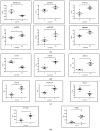Impact of Tyrosine Kinase Inhibitors on the Expression Pattern of Epigenetic Regulators
- PMID: 40282457
- PMCID: PMC12025482
- DOI: 10.3390/cancers17081282
Impact of Tyrosine Kinase Inhibitors on the Expression Pattern of Epigenetic Regulators
Abstract
Background: Advances in molecular genetic diagnostics and emerging opportunities for targeted treatment have opened new horizons in precision oncology. Tyrosine kinase inhibitors (TKI) are the subgroup of these agents with which the most clinical experience has been gathered so far. However, little data is available on the effect of TKI agents on the expression levels of molecules responsible for epigenetic regulation. Methods: In this study, we investigated the effect of in vitro and in vivo treatment with tyrosine kinase inhibitor agents on the expression of epigenetic regulators in hematological malignancies and solid tumors, based on data included in the functional genomics repository Gene Expression Omnibus. Results: Statistical analysis of datasets and series of gene expression patterns revealed numerous significant changes in the levels of epigenetic writers, erasers, microRNAs and members of chromatin-remodeling complexes following TKI treatment. Previously published data about the role of these epigenetic modifiers in malignant diseases has also been summarized. Conclusions: Our results may contribute to the establishment of novel treatment strategies aiming at the combinatorial administration of TKI and epidrugs in cancer, leading to less toxic therapy with further improved results.
Keywords: epigenetics; precision oncology; tyrosine kinase inhibitors.
Conflict of interest statement
The authors declare no conflicts of interest.
Figures






Similar articles
-
Targeting chromatin defects in selected solid tumors based on oncogene addiction, synthetic lethality and epigenetic antagonism.Ann Oncol. 2017 Feb 1;28(2):254-269. doi: 10.1093/annonc/mdw552. Ann Oncol. 2017. PMID: 28426098 Review.
-
Pediatric high-grade glioma: aberrant epigenetics and kinase signaling define emerging therapeutic opportunities.J Neurooncol. 2020 Oct;150(1):17-26. doi: 10.1007/s11060-020-03546-0. Epub 2020 Jun 5. J Neurooncol. 2020. PMID: 32504402 Free PMC article. Review.
-
MicroRNAs and Metabolism: Revisiting the Warburg Effect with Emphasis on Epigenetic Background and Clinical Applications.Biomolecules. 2021 Oct 17;11(10):1531. doi: 10.3390/biom11101531. Biomolecules. 2021. PMID: 34680164 Free PMC article. Review.
-
Insights into novel emerging epigenetic drugs in myeloid malignancies.Ther Adv Hematol. 2019 Aug 6;10:2040620719866081. doi: 10.1177/2040620719866081. eCollection 2019. Ther Adv Hematol. 2019. PMID: 31431820 Free PMC article. Review.
-
Targeting Epigenetics in Cancer.Annu Rev Pharmacol Toxicol. 2018 Jan 6;58:187-207. doi: 10.1146/annurev-pharmtox-010716-105106. Epub 2017 Oct 6. Annu Rev Pharmacol Toxicol. 2018. PMID: 28992434 Free PMC article. Review.
References
-
- Botta L., Gatta G., Capocaccia R., Stiller C., Cañete A., Dal Maso L., Innos K., Mihor A., Erdmann F., Spix C., et al. Long-term survival and cure fraction estimates for childhood cancer in Europe (EUROCARE-6): Results from a population-based study. Lancet Oncol. 2022;23:1525–1536. doi: 10.1016/S1470-2045(22)00637-4. - DOI - PubMed
-
- Casolino R., Beer P.A., Chakravarty D., Davis M.B., Malapelle U., Mazzarella L., Normanno N., Pauli C., Subbiah V., Turnbull C., et al. Interpreting and integrating genomic tests results in clinical cancer care: Overview and practical guidance. CA Cancer J. Clin. 2024;74:264–285. doi: 10.3322/caac.21825. - DOI - PubMed
LinkOut - more resources
Full Text Sources

